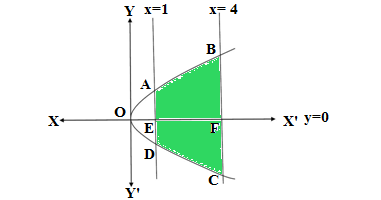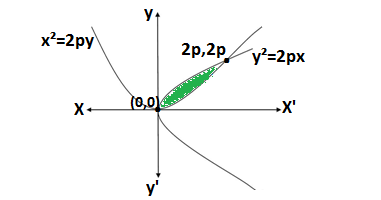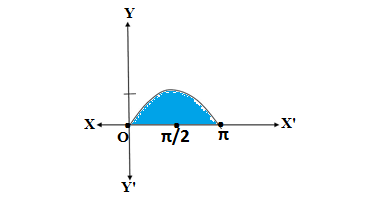Class 12 Maths Important Questions-Application of Integrals
Q1.Find the area of the region bounded by the curve y2 = x and the lines x = 1, x = 4 and x – axis.
Ans. The given curve y2 = x and the lines x =1,x =4
Also given x -axis (i.e y =0)
Drawng the graph of the curve (i.e parabola) y2 = x and the lines x =1,x =4 and y=0
The given curve is
y2 = x
y = ±√x
Area of the region covered by the parabola and the lines x =1 ,x=4, and X-axis is symmetrical about the X-axis which is shown by the shaded region
∴ Area of ABCD = 2 area ABFE
Area ABFE = Integration of y with respect to x within the limits x =1 and x =2
= 4/3(2³ -1) = 4/3(8 -1) =28/3
Therefore the area of the shaded region is (28/3) square unit
Click for online shopping
Future Study Point.Deal: Cloths, Laptops, Computers, Mobiles, Shoes etc
Q2.Find the area of the region bounded by the curves y²=2px and x²=2py.
Ans. Solving equations y²=2px and x²=2py,we get
Putting the value y = √(2px) in the equation x²=2py
x²=2p√(2px)
Squaring both sides
x4 =4p²× 2px
x4 -8p³x =0
x(x³ -8p³) =0
x =0
x³ -8p³ =0
x³ = 8p³
x = 2p
When x = 0 then y=0 and when x =2p then y²=2p(2p)⇒ y =2p
Therefore area bounded by both curves is shown as shaded region in the following graph
The area of the shaded region = The integration of y with respect to x within the limits x=0 and x=2p
From the curve y²=2px ⇒y =√2px and from the curve x²=2py⇒y=x²/2p
The function representing the shaded region = [√(2px) – x²/2p]
=(8p²/3) – (4p²/3)
=4p²/3
The area covered by both curves is (4p²/3) square unit
Q3.Find the area of the curve y = sinx, between 0 and π.
Ans. Drawing the curve y = sinx
Area of the curve y = sinx, between 0 and π = Area of the shaded region
Area of the shaded region=Integraion of the function y with respect to x within the limit 0 and π
=-( cos π – cos 0)
= -(-1 -1)
=-(-2) = 2
Hence area of the shaded region is 2 square unit
Q4.Find the area of the region bounded by the two parabolas y = x2 and y2 = x
Ans. The given curves are y = x2 and y2 = x
Solving both curves
Putting the value y = x² in the equation y2 = x
x4=x
x4-x=0
x(x³ – 1) =0
x =0, x =1
Putting x =0,y =0 and putting x =1,y=1 indicates that both curves meet at (0,0) and (1,1)
y = x² and y2 = x⇒y = √x
The function representing the shaded region = √x -x² since √x ≥ x²
Area of the shaded region = integration of the function (√x -x²) within the limit 0 and 1
=[2/3 – 1/3] = 1/3
Hence area bounded by the given curves is 1/3 square unit
Q5. Find the area enclosed by the circle x² + y² = 4 and the straight line x + y =2 .
Ans. Solving the equation of the circle and the line
x² + y² = 4⇒ y =√( 4-x²) and y = 2- x
√( 4-x²) = 2- x
Squaring both sides
4 -x² = 4 + x² – 4x
2x² – 4x = 0
x² – 2x = 0
x( x -2) = 0
x =0 and x =2
Putting x = 0 and x =2 in the equation x + y =2
When x = 0,y =2 and when x =2 ,y = 0
The straight line and the circle intersects at (0,2) and (2,0)
Area of the shaded region = Area of the quadrant – Area of the triangle
Area of the quadrant = Integration of the y = √(2² – x²) w.r.t x within the limits x =0 and x =2
= 2×π/2 = π
Area of the quadrant = π square unit
Area of the triangle = (1/2)×2×2 = 2 square unit
Area of the shaded region = (π -2)square unit
Q6.Find the area of the region bounded by the curve y = x³, y = x +6 and y-axis.
Ans. Solving the equation y = x³, y = x +6
Substituting y =x³ in second equation
x³ = x +6
x³ -x -6 =0
x =2 satisfies the above equation
Factorizing the above equation by the remiender theorem
x²(x -2) +2x² -x -6 =0
x²(x -2) +2x(x -2) +4x -x -6 =0
x²(x -2) +2x(x -2) +3x-6 =0
x²(x -2) +2x(x -2) +3(x-2) =0
(x -2)( x² +2x +3) =0
Since the roots of the equation x² +2x +3 are not real,therefore putting x =2 in y = x +6,we get y =8
Hence the curve and the given line intersect at only one point (2,8)
Drawing the graph of y = x³, y = x +6 and y-axis
The shaded region represents the function [(x +6)-x³]
The area of the shaded region =Integrating the function [(x +6)-x³] w r t x within the limits x =0 and x =2
=(2²/2 +6×2 – 24/4]
4/2 +12 – 16/4
=2 +12 -4 = 10 square unit
You can compensate us by donating any amount of money for our survival
Our Paytm No 9891436286
NCERT Solutions of Science and Maths for Class 9,10,11 and 12
NCERT Solutions of class 9 maths
| Chapter 1- Number System | Chapter 9-Areas of parallelogram and triangles |
| Chapter 2-Polynomial | Chapter 10-Circles |
| Chapter 3- Coordinate Geometry | Chapter 11-Construction |
| Chapter 4- Linear equations in two variables | Chapter 12-Heron’s Formula |
| Chapter 5- Introduction to Euclid’s Geometry | Chapter 13-Surface Areas and Volumes |
| Chapter 6-Lines and Angles | Chapter 14-Statistics |
| Chapter 7-Triangles | Chapter 15-Probability |
| Chapter 8- Quadrilateral |
NCERT Solutions of class 9 science
CBSE Class 9-Question paper of science 2020 with solutions
CBSE Class 9-Sample paper of science
CBSE Class 9-Unsolved question paper of science 2019
NCERT Solutions of class 10 maths
CBSE Class 10-Question paper of maths 2021 with solutions
CBSE Class 10-Half yearly question paper of maths 2020 with solutions
CBSE Class 10 -Question paper of maths 2020 with solutions
CBSE Class 10-Question paper of maths 2019 with solutions
NCERT solutions of class 10 science
Solutions of class 10 last years Science question papers
CBSE Class 10 – Question paper of science 2020 with solutions
CBSE class 10 -Latest sample paper of science
NCERT solutions of class 11 maths
| Chapter 1-Sets | Chapter 9-Sequences and Series |
| Chapter 2- Relations and functions | Chapter 10- Straight Lines |
| Chapter 3- Trigonometry | Chapter 11-Conic Sections |
| Chapter 4-Principle of mathematical induction | Chapter 12-Introduction to three Dimensional Geometry |
| Chapter 5-Complex numbers | Chapter 13- Limits and Derivatives |
| Chapter 6- Linear Inequalities | Chapter 14-Mathematical Reasoning |
| Chapter 7- Permutations and Combinations | Chapter 15- Statistics |
| Chapter 8- Binomial Theorem | Chapter 16- Probability |
CBSE Class 11-Question paper of maths 2015
CBSE Class 11 – Second unit test of maths 2021 with solutions
NCERT solutions of class 12 maths
| Chapter 1-Relations and Functions | Chapter 9-Differential Equations |
| Chapter 2-Inverse Trigonometric Functions | Chapter 10-Vector Algebra |
| Chapter 3-Matrices | Chapter 11 – Three Dimensional Geometry |
| Chapter 4-Determinants | Chapter 12-Linear Programming |
| Chapter 5- Continuity and Differentiability | Chapter 13-Probability |
| Chapter 6- Application of Derivation | CBSE Class 12- Question paper of maths 2021 with solutions |
| Chapter 7- Integrals | |
| Chapter 8-Application of Integrals |










